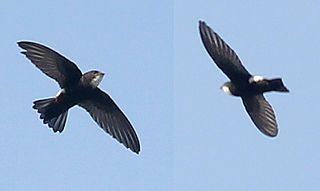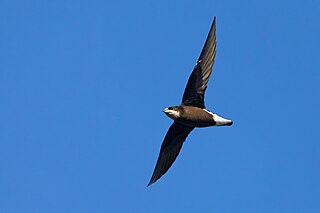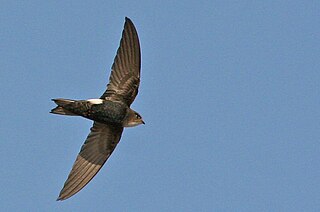
The common swift is a medium-sized bird, superficially similar to the barn swallow or house martin but somewhat larger, though not stemming from those passerine species, being in the order Apodiformes. The resemblances between the groups are due to convergent evolution, reflecting similar contextual development. The swifts' nearest relatives are the New World hummingbirds and the Southeast Asian treeswifts.

The swifts are a family, Apodidae, of highly aerial birds. They are superficially similar to swallows, but are not closely related to any passerine species. Swifts are placed in the order Apodiformes with hummingbirds. The treeswifts are closely related to the true swifts, but form a separate family, the Hemiprocnidae.

The little swift, is a small species of swift found in Africa and southwestern Asia, and are vagrants and local breeders in southern Europe. They are found both in urban areas and at rocky cliffs where they build nests in a way typical of all members of the order Apodiformes. The genus name Apus is Latin for a swift, thought by the ancients to be a type of swallow without feet. The Latin specific affinis means similar to or related to, but in this case the species that the little swift supposedly resembles is not clear from the description. A population formerly considered to be an eastern subspecies of little swift is now separated as a distinct species, the house swift.

The house swift is a species of swift in the family Apodidae. It is found in Japan, Nepal, and Southeast Asia. It is capable of flying long distances by alternately shutting off hemispheres of its brain in-flight.

The pallid swift is a swift. Swifts have very short legs which they use only for clinging to vertical surfaces. The genus name Apus is Latin for a swift, thought by the ancients to be a type of swallow with no feet, and pallidus is Latin for "pale". They never settle voluntarily on the ground. Swifts spend most of their lives in the air, living on the insects they catch in their beaks. They drink on the wing.

The Pacific swift or fork-tailed swift is a species of bird that is part of the Swift family. It breeds in eastern Asia. It is strongly migratory, spending the northern hemisphere's winter in Southeast Asia and Australia. The general shape and blackish plumage recall its relative, the common swift, from which it is distinguished by a white rump band and heavily marked underparts. The sexes are identical in appearance, although young birds can be identified by pale fringes to the wing feathers that are absent in adults. This swift's main call is a screech typical of its family. It is one of a group of closely related Asian swifts formerly regarded as one species.

The white-throated needletail, also known as needle-tailed swift or spine-tailed swift, is a large swift in the genus Hirundapus. It is reputed to reach speeds of up to 170 km/h in horizontal flight, but this is unverified because the methods used to measure its speed have not been published.

The plain swift is a medium-sized swift. Although this bird is superficially similar to a barn swallow or house martin, it is not related to those passerine species. The resemblances between the groups are due to convergent evolution reflecting similar life styles.

The white-rumped swift is a species of swift. Although this small bird is superficially similar to a house martin, it is not closely related to that passerine species. The resemblances between the swallows and swifts are due to convergent evolution reflecting similar life styles.

The bird genus Apus comprise some of the Old World members of the family Apodidae, commonly known as swifts.

The black-bellied tern is a tern found near large rivers in the Indian subcontinent, its range extending from Pakistan, Nepal and India to Myanmar. It has become very scarce in the eastern part of its range and the International Union for Conservation of Nature has assessed its conservation status as being endangered.

The African black swift, also known as the African swift or black swift, is a medium-sized bird in the swift family. It breeds in Africa discontinuously from Liberia, Cameroon, Zaire, Uganda and Kenya southwards to South Africa. The "black swifts" of Madagascar and the Comoros are either taken as two subspecies of the African black swift, or otherwise deemed a full species, the Malagasy black swift.

The long-tailed finch is a common species of estrildid finch found in northern Australia, from the Kimberley region to the Gulf of Carpentaria. It is a predominantly fawn-coloured bird with a pale grey head and prominent black bib and eyes. It inhabits dry savannah habitats in Australia and adapts readily to aviculture.

The Horus swift is a small bird in the swift family. Horus, whose name this bird commemorates, was the ancient Egyptian god of the sun, son of Osiris and Isis.
The Cape Verde swift or Alexander's swift is a small bird of the swift family found only in the Cape Verde Islands. It has been recorded from all the islands except Santa Luzia although it probably breeds only on Santiago, Fogo, Brava, Santo Antão and São Nicolau. It is generally common with a stable population and is not considered to be threatened. The name Alexander's swift commemorates Boyd Alexander, an English ornithologist who led two expeditions to the islands in 1897.

The Malagasy black swift or Madagascar swift, is a species of swift in the family Apodidae. It is endemic to Madagascar and the Comoro Islands.
Bates's swift is a species of small swift in the family Apodidae which is found in western Africa.

Bradfield's swift is a species of swift in the family Apodidae.
The Nyanza swift(Apus niansae) is a species of swift in the family Apodidae. It is found in Eritrea, Ethiopia, Kenya, Somalia, South Sudan, Tanzania, and Uganda.
The Fernando Po swift is a species of swift in the family Apodidae.
















